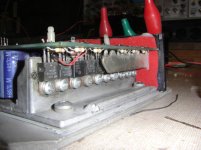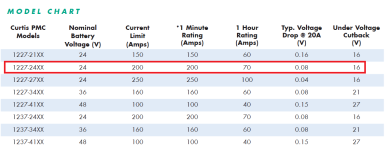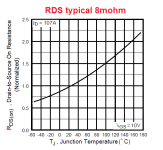ElectronS
10 mW
- Joined
- Mar 4, 2013
- Messages
- 31
Hi guys i am a newbie EE building a 2 parallel mosfet per side power stage , and would like to know how much current is possible to pass for 2 minutes (peak) and 60mins continous. by figuring out how much thermal power a to-247 package can handle from your experience .
The power stage will be something like this :


except that the bottum plate attacked to the U shaped heat spreader will be finned 20x20cm heatsink with a 20-to 30CFM fan
The mosfet RDsOn is 2mohm (Tjunction max is 175 , though i would like to stay way below this number maybe 125degree max)
the thermal resistance from jucntion to heatsink (jun-to case + case to heatspreader + heatspreader-to heatsink ) is approximatley 5 degree C/W .
is 16w (~200A)a realistic number for 2mins peak ?
is 10w (~150A)a realistic number for 60mins continuous ?
EDIT: ADD more details
For example curtis 1227-2402 controller (which is a very similar controller to one in the picture) is rated for 200A (1-2 minutes) and 70A for 1 hour

it uses 5 mosfets in parallel per side ( x4 sides because it is an H bridge ) , mosfet is IRF3205 , the mosfets are connected to the aluminum block using grease only (to share current maybe) and the aluminum block then it is insulated from the buttom plate using silicon pad

assume the mosfet is at 100degree max , the resistance will be 1.5x8mOhm = 12mOhm , at 200A , each mosfet will be conducting 40A , then Ploss per mosfet is 40x40x12/1000= 19.2W !!!!
I thought this number was crazy for to-220 , Thats why i asked my question about the to-247.
The power stage will be something like this :

except that the bottum plate attacked to the U shaped heat spreader will be finned 20x20cm heatsink with a 20-to 30CFM fan
The mosfet RDsOn is 2mohm (Tjunction max is 175 , though i would like to stay way below this number maybe 125degree max)
the thermal resistance from jucntion to heatsink (jun-to case + case to heatspreader + heatspreader-to heatsink ) is approximatley 5 degree C/W .
is 16w (~200A)a realistic number for 2mins peak ?
is 10w (~150A)a realistic number for 60mins continuous ?
EDIT: ADD more details
For example curtis 1227-2402 controller (which is a very similar controller to one in the picture) is rated for 200A (1-2 minutes) and 70A for 1 hour

it uses 5 mosfets in parallel per side ( x4 sides because it is an H bridge ) , mosfet is IRF3205 , the mosfets are connected to the aluminum block using grease only (to share current maybe) and the aluminum block then it is insulated from the buttom plate using silicon pad

assume the mosfet is at 100degree max , the resistance will be 1.5x8mOhm = 12mOhm , at 200A , each mosfet will be conducting 40A , then Ploss per mosfet is 40x40x12/1000= 19.2W !!!!
I thought this number was crazy for to-220 , Thats why i asked my question about the to-247.

